- Accueil
- Pages cachées
- 04/01/2024 NEWS
04/01/2024 NEWS
INSTITUT SUPERIEUR D'ANTHROPOLOGIE
INSTITUT OF ANTHROPOLOGY
COURS ONLINE – COURS A DISTANCE
INSCRIPTIONS OUVERTES
REGISTER NOW
INDE – 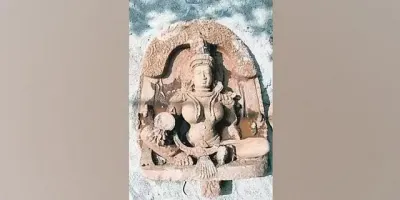 Mysuru - Two broken Jain sculptures belonging to the 11th century were found while digging a drain at Varuna village of Mysuru taluk recently. A team comprising ancient history Prof Rangaraj, Archeology Department deputy director Manjula Shashidhar, a representative of Dharmasthala Prasanna Kumar and Mysuru resident Vinod Jain visited the spot and took the sculpture to the archaeology museum. Rangaraj said Varuna, Vajamangala, Talakadu, Hemmige, Mugur and T Narsipur were Jain centres and there are too many sculptures in the region. He said the government must announce a project for excavation which would throw further light on the sculpture.
Mysuru - Two broken Jain sculptures belonging to the 11th century were found while digging a drain at Varuna village of Mysuru taluk recently. A team comprising ancient history Prof Rangaraj, Archeology Department deputy director Manjula Shashidhar, a representative of Dharmasthala Prasanna Kumar and Mysuru resident Vinod Jain visited the spot and took the sculpture to the archaeology museum. Rangaraj said Varuna, Vajamangala, Talakadu, Hemmige, Mugur and T Narsipur were Jain centres and there are too many sculptures in the region. He said the government must announce a project for excavation which would throw further light on the sculpture.
11th century Jain idols found in Mysuru village- The New Indian Express
CANADA - Mount Edziza - In the depths of the Mount Edziza Park, Canada, in the territory of the Tahltan tribe, a team of archaeologists has unraveled ancient secretss. This area, known for its extensive obsidian quarries and artifact scatters near Mount Goat and the Kitsu Plateau, has become an open book of ancient history. The thaw, in this case, has not only brought climatic problems in Canada, but also archaeological finds. During meticulous investigation, more than 50 perishable artifacts emerged from the ice. From sewn birch bark containers, wooden walking sticks, to an atlatl dart fragment and a sewn leather boot, each piece tells a story. Imagine the footprints of ancient hunters, reflected in these objects, dating back 7,000 years. The landscape is a tapestry of obsidian artifacts, with bifaces, cores and flakes scattered throughout, offering a window into the tool-making techniques of our ancestors.
The thaw reveals an archaeological treasure from more than 7,000 years ago - Ruetir
MONGOLIE – 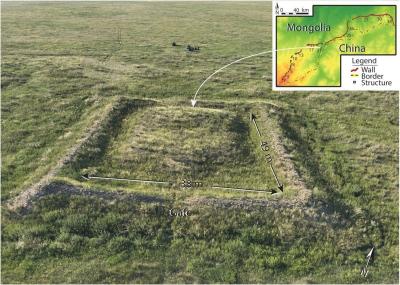 - Researchers have studied the 405-km wall system in eastern Mongolia known as the Mongolian Arc to learn more about its history and purpose. The “Mongolian Arc” consists of an earthen wall, a trench, and 34 structures. This section of the Great Wall of China that extends into Mongolia has been analyzed for the first time, allowing them to present some speculative insights into the history and function of this enormous structure. Running roughly parallel to the border between China and Mongolia, the ancient barrier extends from Sukhbaatar Province to Dornod Province in northeastern Mongolia, where winter temperatures often fall as low as -25 degrees Celsius (-13 degrees Fahrenheit).Based on historical records, researchers suggest that the entire system was built between the 11th and 13th centuries AD, but archaeological studies to date are insufficient to more accurately date the construction times of its different parts. The study authors analyzed the wall and its associated structures using satellite images, Chinese atlases, and Soviet maps in addition to direct field observations, noting that “the Mongolian Arc, despite its magnitude, has been largely overlooked in existing academic discourse.” In their paper published in the Journal of Field Archaeology, the team describes the techniques and technology they used to study the wall. Researchers’ most striking finding was that the Mongolian Arc contains numerous large gaps, suggesting that it was built in a hurry and therefore never fully fortified. There is also evidence that suggests the wall was built as a means of controlling the movement of people or animals or perhaps as a part of a taxation scheme. “One possible explanation for the gaps, which were points of vulnerability in the system, is that the Mongolian Arc was hastily built during the final years of the Jin dynasty as a defense against the expected invading Mongol armies,” write the researchers. Such theories arose as it became clear that the wall would not have served as much of a barrier—many of its outposts, for example, were in locations with limited views into the surrounding territory. The entire wall system to which the Mongolian Arc belongs has received different names in the research literature. It has been called the “Jin border trench”, the “Jin long wall,” and the “Liao-Jin Wall”. It is also one of the most enigmatic long wall and trench systems in Chinese and Mongolian history. Despite its size and complexity, it is unclear when it was constructed, who built it, and for what purpose. It is not even clear whether the entire array of walls was built at the same time or if, as researchers hypothesize, it is an accumulation of different projects built over a long period of time.
- Researchers have studied the 405-km wall system in eastern Mongolia known as the Mongolian Arc to learn more about its history and purpose. The “Mongolian Arc” consists of an earthen wall, a trench, and 34 structures. This section of the Great Wall of China that extends into Mongolia has been analyzed for the first time, allowing them to present some speculative insights into the history and function of this enormous structure. Running roughly parallel to the border between China and Mongolia, the ancient barrier extends from Sukhbaatar Province to Dornod Province in northeastern Mongolia, where winter temperatures often fall as low as -25 degrees Celsius (-13 degrees Fahrenheit).Based on historical records, researchers suggest that the entire system was built between the 11th and 13th centuries AD, but archaeological studies to date are insufficient to more accurately date the construction times of its different parts. The study authors analyzed the wall and its associated structures using satellite images, Chinese atlases, and Soviet maps in addition to direct field observations, noting that “the Mongolian Arc, despite its magnitude, has been largely overlooked in existing academic discourse.” In their paper published in the Journal of Field Archaeology, the team describes the techniques and technology they used to study the wall. Researchers’ most striking finding was that the Mongolian Arc contains numerous large gaps, suggesting that it was built in a hurry and therefore never fully fortified. There is also evidence that suggests the wall was built as a means of controlling the movement of people or animals or perhaps as a part of a taxation scheme. “One possible explanation for the gaps, which were points of vulnerability in the system, is that the Mongolian Arc was hastily built during the final years of the Jin dynasty as a defense against the expected invading Mongol armies,” write the researchers. Such theories arose as it became clear that the wall would not have served as much of a barrier—many of its outposts, for example, were in locations with limited views into the surrounding territory. The entire wall system to which the Mongolian Arc belongs has received different names in the research literature. It has been called the “Jin border trench”, the “Jin long wall,” and the “Liao-Jin Wall”. It is also one of the most enigmatic long wall and trench systems in Chinese and Mongolian history. Despite its size and complexity, it is unclear when it was constructed, who built it, and for what purpose. It is not even clear whether the entire array of walls was built at the same time or if, as researchers hypothesize, it is an accumulation of different projects built over a long period of time.
Mysterious Mongolian Arc in Eastern Mongolia Studied for the First Time - Arkeonews
ANGLETERRE – 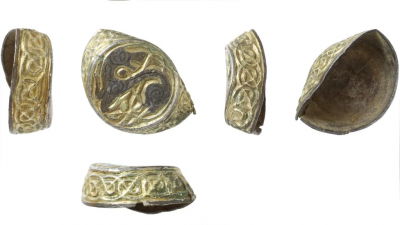
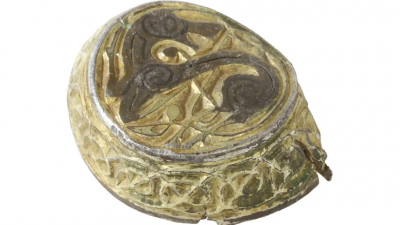 Langham - An enigmatic Anglo-Saxon object has been unearthed in a captivating discovery near Langham, Norfolk, East of England. This gilded silver artifact, which dates from the late eighth or early ninth century, is both a testament to the sophistication of ancient artisanship and a mystery that has yet to be solved. Despite the skill that would have been required to make it, the roughly 1,200-year-old object has no apparent purpose and remains a mystery to archaeologists. Detectorists in Norfolk found the gilded silver relic, which is 19.4mm (0.7in) in diameter with intricate designs depicting a stylized animal looking over its shoulder. The artifact boasts a meticulous design with a flat, circular top and short, straight sides forming a shallow, hollow cylinder. The object is adorned with a meticulously crafted spiral pattern and a backward-looking animal, possibly a horse. This design bears a striking resemblance to the style found in the Book of Kells or the Lindisfarne Gospel, both renowned for their intricate illustrations. This piece was created using a sophisticated technique known as gilding, in which mercury was mixed with powdered gold to accentuate the design – a process indicative of the period’s high level of craftsmanship. Helen Geake, the Norfolk Finds Liaison Officer and a respected historian commented on the artefact. She believes the ornate trinket reveals the skill of Anglo-Saxon craftsmen. She told the BBC: “It was made by someone with a real eye for loveliness. It is believed the design would have been created using gold and mercury imported from Spain. While the skill and expense suggest the object was as important as personal jewelry and the ornaments added to sacred texts, experts do not know what the artifact was used for. Dr. Helen Geake speculates that it might have been part of a staff, the rest of which has decayed over the centuries. The discovery of this Anglo-Saxon object not only adds to our understanding of historical artisanship, but it also piques the interest of experts and history buffs alike. As we delve deeper into the mysteries of the past, such discoveries provide fascinating glimpses into our forefathers’ creative prowess and technical skills.
Langham - An enigmatic Anglo-Saxon object has been unearthed in a captivating discovery near Langham, Norfolk, East of England. This gilded silver artifact, which dates from the late eighth or early ninth century, is both a testament to the sophistication of ancient artisanship and a mystery that has yet to be solved. Despite the skill that would have been required to make it, the roughly 1,200-year-old object has no apparent purpose and remains a mystery to archaeologists. Detectorists in Norfolk found the gilded silver relic, which is 19.4mm (0.7in) in diameter with intricate designs depicting a stylized animal looking over its shoulder. The artifact boasts a meticulous design with a flat, circular top and short, straight sides forming a shallow, hollow cylinder. The object is adorned with a meticulously crafted spiral pattern and a backward-looking animal, possibly a horse. This design bears a striking resemblance to the style found in the Book of Kells or the Lindisfarne Gospel, both renowned for their intricate illustrations. This piece was created using a sophisticated technique known as gilding, in which mercury was mixed with powdered gold to accentuate the design – a process indicative of the period’s high level of craftsmanship. Helen Geake, the Norfolk Finds Liaison Officer and a respected historian commented on the artefact. She believes the ornate trinket reveals the skill of Anglo-Saxon craftsmen. She told the BBC: “It was made by someone with a real eye for loveliness. It is believed the design would have been created using gold and mercury imported from Spain. While the skill and expense suggest the object was as important as personal jewelry and the ornaments added to sacred texts, experts do not know what the artifact was used for. Dr. Helen Geake speculates that it might have been part of a staff, the rest of which has decayed over the centuries. The discovery of this Anglo-Saxon object not only adds to our understanding of historical artisanship, but it also piques the interest of experts and history buffs alike. As we delve deeper into the mysteries of the past, such discoveries provide fascinating glimpses into our forefathers’ creative prowess and technical skills.
CHINE – 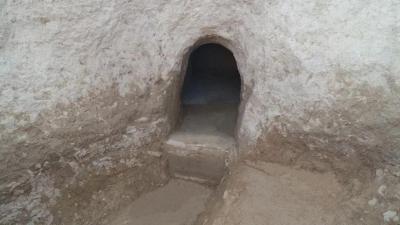
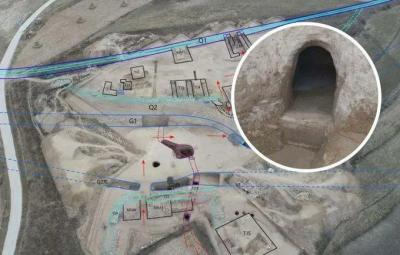 Houchengzui - Archaeologists working at Houchengzui Stone City in Inner Mongolia, an autonomous region of northern China, have made a new discovery. They’ve found a system of old tunnels that’s about 4,300 to 4,500 years old. This massive dig site, which is around 1.38 million square meters big, sits on the north side of the Hun River in Qingshuihe County, Inner Mongolia. Researchers have done careful studies to confirm the city’s history and importance.It turns out that it’s the biggest, most important, and most heavily protected early Longshan period stone city found in Inner Mongolia so far, according to Archaeology Mag. The Institute of Archaeology, Chinese Academy of Social Sciences (CASS), leading the recent digging work, has unveiled a complex triple defense system and a detailed network of tunnels underground. The Houchengzui Stone City is formed like an ellipse and includes an inner city, an outer city, and a walled gatehouse. It spans about 1200 meters in length and 1150 meters in width. Over the course of five years of archaeological digs, researchers uncovered the city’s triple defense system. This system involves the main city wall, the main city gate, horse faces, gatehouse walls, terraces, and moats. The excavations have also revealed three city gates: the main city gate (CM1), the urn city gate (CM2), and the outer urn city gate (CM3). The main city gate is positioned in the center of the outer city wall and has a rectangular design. It features a doorway surrounded by earthen platforms on both sides, according to Heritage Daily. Yet, the latest dig has revealed an extra layer of protection—an unseen underground network made up of six intersecting tunnels. These tunnels, positioned at depths ranging from 1.5 to 6 meters, spread out in a radial pattern from the center of the city. The underground tunnels at Houchengzui played a double role, functioning as both an ancient transportation network and a method for defense and attack. These tunnels have arched ceilings similar to the architectural style of Longshan period cave dwellings. They stand at 1 to 2 meters in height and 1.5 meters in width. Moreover, the tool marks on the tunnel walls are clearly visible, as reported by Archaeology Mag. Archaeologists think that the intricate layout of Houchengzui Stone City, featuring detailed defense systems and concealed tunnels, highlights its cultural significance in military defense and its strategic position. Ongoing digs are still revealing more information about the city’s history, such as tall structures, burial sites, and other architectural remnants.
Houchengzui - Archaeologists working at Houchengzui Stone City in Inner Mongolia, an autonomous region of northern China, have made a new discovery. They’ve found a system of old tunnels that’s about 4,300 to 4,500 years old. This massive dig site, which is around 1.38 million square meters big, sits on the north side of the Hun River in Qingshuihe County, Inner Mongolia. Researchers have done careful studies to confirm the city’s history and importance.It turns out that it’s the biggest, most important, and most heavily protected early Longshan period stone city found in Inner Mongolia so far, according to Archaeology Mag. The Institute of Archaeology, Chinese Academy of Social Sciences (CASS), leading the recent digging work, has unveiled a complex triple defense system and a detailed network of tunnels underground. The Houchengzui Stone City is formed like an ellipse and includes an inner city, an outer city, and a walled gatehouse. It spans about 1200 meters in length and 1150 meters in width. Over the course of five years of archaeological digs, researchers uncovered the city’s triple defense system. This system involves the main city wall, the main city gate, horse faces, gatehouse walls, terraces, and moats. The excavations have also revealed three city gates: the main city gate (CM1), the urn city gate (CM2), and the outer urn city gate (CM3). The main city gate is positioned in the center of the outer city wall and has a rectangular design. It features a doorway surrounded by earthen platforms on both sides, according to Heritage Daily. Yet, the latest dig has revealed an extra layer of protection—an unseen underground network made up of six intersecting tunnels. These tunnels, positioned at depths ranging from 1.5 to 6 meters, spread out in a radial pattern from the center of the city. The underground tunnels at Houchengzui played a double role, functioning as both an ancient transportation network and a method for defense and attack. These tunnels have arched ceilings similar to the architectural style of Longshan period cave dwellings. They stand at 1 to 2 meters in height and 1.5 meters in width. Moreover, the tool marks on the tunnel walls are clearly visible, as reported by Archaeology Mag. Archaeologists think that the intricate layout of Houchengzui Stone City, featuring detailed defense systems and concealed tunnels, highlights its cultural significance in military defense and its strategic position. Ongoing digs are still revealing more information about the city’s history, such as tall structures, burial sites, and other architectural remnants.
Archaeologists Find Network of Ancient Tunnels in China (greekreporter.com)
ANGLETERRE – 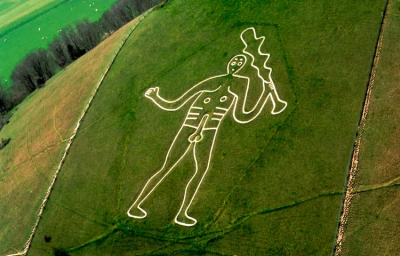 Cerne Abbas - There’s a huge chalk image of a man with a powerful erection and no clothes on his butt located in the hills of Dorset, England. After centuries of speculation, the origins of the Cerne Abbas Giant may finally have been determined, according to a recent study. The Cerne Abbas Giant is a large rural drawing carved into the chalk hillside in the village of Cerne Abbas, Dorset, England. Spanning approximately 180 feet (55 meters), this figure’s origins likely date back to ancient times, but its exact purpose remains uncertain. Some interpret the figure as carrying natural symbolism related to fertility and sexuality, while others see it as purely symbolic of ancient beliefs. Some even postured that the figure was meant to make a mockery of Oliver Cromwell, the 17th-century statesman who was jokingly dubbed “England’s Hercules” by his enemies. But now, after hundreds of years of debate, academics believe they have the answer to the hillside riddle and declared the figure probably depicts the Greek hero Hercules. Hence, he was probably created as a pagan idol during the Iron Age in Britain. Historians suggest the hill the huge chalk carving is located on could have once been a mustering point for Anglo-Saxon troops, with the giant acting as a rallying symbol. However, the story was later rewritten by meddling monks, perhaps hoping to secure the fortunes of the local patron saint. In a paper published in journal Speculum, researchers say the giant was adopted by Christians who claimed it depicted their saint. It also argues the ‘British god’ idea was a myth which arose from a mistranslation. According to this theory, the prominent phallus was to mock Cromwell’s Puritanism. The researchers note that Hercules is almost always depicted in artworks with a club, as well as other motifs seen on the Cerne Abbas Giant, such as nudity and prominent ribs. “At first glance, an early medieval date seems odd for a figure which looks like the classical god Hercules,” Dr Helen Gittos and Dr Thomas Morcom write. “The club is the clue. Hercules was one of the most frequently depicted figures in the classical world, and his distinctively knotted club acted as an identificatory label, like the keys of Saint Peter or the wheel of Saint Catherine. He was usually depicted in motion, as at Cerne, and the ribs, lower line of the stomach, and nakedness are all typical,” the study authors explain. “Alongside his club, he was most often associated with his lionskin mantle, and it is likely that one of these originally hung from the giant’s left arm,” they add. Despite the pagan imagery, the artwork is relatively recent and dates to the early Middle Ages, sometime between 700 CE and 1100 CE. Researchers say there are many references to Hercules in the British Isles during the time the giant was constructed. Another theory came to prominence after the giant was dated, with people claiming it was a depiction of an Anglo-Saxon god called Helith. This has been discounted by modern theories. Researchers Morcom and Gittos traced the root of this idea to one text, with the name Helith coming from a 13th-century mistranslation of the Latin word for Elijah, the Old Testament prophet. It seems that Helith never existed. Even though the most recent study purports to have provided an answer to the giant’s origins mystery, scientists acknowledge that the real significance of the Cerne Abbas will likely remain a matter of debate for many years to come.
Cerne Abbas - There’s a huge chalk image of a man with a powerful erection and no clothes on his butt located in the hills of Dorset, England. After centuries of speculation, the origins of the Cerne Abbas Giant may finally have been determined, according to a recent study. The Cerne Abbas Giant is a large rural drawing carved into the chalk hillside in the village of Cerne Abbas, Dorset, England. Spanning approximately 180 feet (55 meters), this figure’s origins likely date back to ancient times, but its exact purpose remains uncertain. Some interpret the figure as carrying natural symbolism related to fertility and sexuality, while others see it as purely symbolic of ancient beliefs. Some even postured that the figure was meant to make a mockery of Oliver Cromwell, the 17th-century statesman who was jokingly dubbed “England’s Hercules” by his enemies. But now, after hundreds of years of debate, academics believe they have the answer to the hillside riddle and declared the figure probably depicts the Greek hero Hercules. Hence, he was probably created as a pagan idol during the Iron Age in Britain. Historians suggest the hill the huge chalk carving is located on could have once been a mustering point for Anglo-Saxon troops, with the giant acting as a rallying symbol. However, the story was later rewritten by meddling monks, perhaps hoping to secure the fortunes of the local patron saint. In a paper published in journal Speculum, researchers say the giant was adopted by Christians who claimed it depicted their saint. It also argues the ‘British god’ idea was a myth which arose from a mistranslation. According to this theory, the prominent phallus was to mock Cromwell’s Puritanism. The researchers note that Hercules is almost always depicted in artworks with a club, as well as other motifs seen on the Cerne Abbas Giant, such as nudity and prominent ribs. “At first glance, an early medieval date seems odd for a figure which looks like the classical god Hercules,” Dr Helen Gittos and Dr Thomas Morcom write. “The club is the clue. Hercules was one of the most frequently depicted figures in the classical world, and his distinctively knotted club acted as an identificatory label, like the keys of Saint Peter or the wheel of Saint Catherine. He was usually depicted in motion, as at Cerne, and the ribs, lower line of the stomach, and nakedness are all typical,” the study authors explain. “Alongside his club, he was most often associated with his lionskin mantle, and it is likely that one of these originally hung from the giant’s left arm,” they add. Despite the pagan imagery, the artwork is relatively recent and dates to the early Middle Ages, sometime between 700 CE and 1100 CE. Researchers say there are many references to Hercules in the British Isles during the time the giant was constructed. Another theory came to prominence after the giant was dated, with people claiming it was a depiction of an Anglo-Saxon god called Helith. This has been discounted by modern theories. Researchers Morcom and Gittos traced the root of this idea to one text, with the name Helith coming from a 13th-century mistranslation of the Latin word for Elijah, the Old Testament prophet. It seems that Helith never existed. Even though the most recent study purports to have provided an answer to the giant’s origins mystery, scientists acknowledge that the real significance of the Cerne Abbas will likely remain a matter of debate for many years to come.
The Mysterious Origins of the Cerne Abbas Giant Finally Revealed - Arkeonews
TURQUIE – 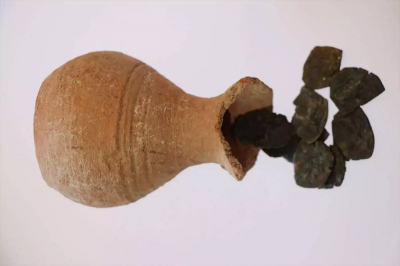 Hadrianopolis - Explaining the discoveries within a particular building whose exact function remains partially ambiguous, Çelikbaş suggested: “We presume it might have served as a kitchen based on the artifacts found within. Various vessels and kitchen utensils were among the unearthed items. Stratigraphy indicates the building’s prolonged use, though specifics about its final phase remain elusive.” Remarkably, a significant archaeological finding emerged from this area in the form of a money box containing 10 coins dating back to the era of Constans II, believed to span from A.D. 641 to 666, marking the apparent culmination of the building’s usage during the seventh century. While defining these coins as a treasure in archaeological terms, Çelikbaş suggested an alternative use, saying: “We suspect it was employed as a primitive form of a piggy bank, possibly by a female member of the household during that era, rather than for hiding or burying money.” The unearthing of these coins provides a glimpse into the final phase of the building’s utilization. It offers valuable insights into ancient domestic practices, highlighting the intersection of archaeology and everyday life in antiquity.
Hadrianopolis - Explaining the discoveries within a particular building whose exact function remains partially ambiguous, Çelikbaş suggested: “We presume it might have served as a kitchen based on the artifacts found within. Various vessels and kitchen utensils were among the unearthed items. Stratigraphy indicates the building’s prolonged use, though specifics about its final phase remain elusive.” Remarkably, a significant archaeological finding emerged from this area in the form of a money box containing 10 coins dating back to the era of Constans II, believed to span from A.D. 641 to 666, marking the apparent culmination of the building’s usage during the seventh century. While defining these coins as a treasure in archaeological terms, Çelikbaş suggested an alternative use, saying: “We suspect it was employed as a primitive form of a piggy bank, possibly by a female member of the household during that era, rather than for hiding or burying money.” The unearthing of these coins provides a glimpse into the final phase of the building’s utilization. It offers valuable insights into ancient domestic practices, highlighting the intersection of archaeology and everyday life in antiquity.
1,400-year-old coins found in a piggy bank in ancient city of Hadrianopolis – Arke onews
ITALIE – 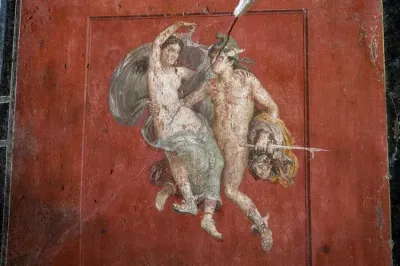 Pompéi - Inside the Pompeii archaeological site, a new project is reviving ancient textile dyeing techniques to show another side of daily life before the city was destroyed by the eruption of Mount Vesuvius in A.D. 79. The inspiration for this endeavour stems from frescoes discovered within the archaeological site depicting winged cupids dyeing cloth, harvesting grapes for wine, and crafting perfumes. Describing the connection between the frescoes and reality, Gabriel Zuchtriegel, the director of the archaeological site, remarked, "It is very close to the actual reality." o bring this project to fruition, Zuchtriegel enlisted the expertise of Claudio Cutuli, one of the world's few remaining master dyer. Cutuli utilises dyes derived from plants in his own Pompeii-inspired clothing line. For instance, he employs the root of "rubia tinctorum," or rose madder, to achieve the renowned Pompeiian red. Additionally, walnut husks contribute to brown, elderberries to black and gray, and cardamom to amber, yellow, and various shades of green. Using this Pompeiian colour palette, Cutuli dyes scarves adorned with motifs inspired by the frescoes found in the House of Vetti, including those featuring cupids. The opulent residence, much like the entirety of Pompeii, was entombed under volcanic ash. Half of the profits from the scarves' sale will help fund further restoration efforts at the once-sprawling city, where gardeners recently recreated a nursery that includes plants that were used for dyeing before Pompeii's destruction. Garden historian Maurizio Bartolini said that roots, bark and flowers were often used in dyeing. Rosehip, for example, made a soft pink “that was one of the most used colours,’’ he said. Frescoes in the archaeological site show wealthy Pompeiians dressed brightly in purple, green, pinks, blues and yellows. The hues were achieved by boiling the dyed textiles in metal-lined vats at workshops run by slaves who, by contrast, wore plain, brown tunics. “It’s quite unpleasant conditions for the slaves who worked here,” archaeologist Sophie Hay said. “You have got the furnaces going, and it would be hot, crowded and noisy, because people would be shouting when they come in to see if their stuff is ready yet.”
Pompéi - Inside the Pompeii archaeological site, a new project is reviving ancient textile dyeing techniques to show another side of daily life before the city was destroyed by the eruption of Mount Vesuvius in A.D. 79. The inspiration for this endeavour stems from frescoes discovered within the archaeological site depicting winged cupids dyeing cloth, harvesting grapes for wine, and crafting perfumes. Describing the connection between the frescoes and reality, Gabriel Zuchtriegel, the director of the archaeological site, remarked, "It is very close to the actual reality." o bring this project to fruition, Zuchtriegel enlisted the expertise of Claudio Cutuli, one of the world's few remaining master dyer. Cutuli utilises dyes derived from plants in his own Pompeii-inspired clothing line. For instance, he employs the root of "rubia tinctorum," or rose madder, to achieve the renowned Pompeiian red. Additionally, walnut husks contribute to brown, elderberries to black and gray, and cardamom to amber, yellow, and various shades of green. Using this Pompeiian colour palette, Cutuli dyes scarves adorned with motifs inspired by the frescoes found in the House of Vetti, including those featuring cupids. The opulent residence, much like the entirety of Pompeii, was entombed under volcanic ash. Half of the profits from the scarves' sale will help fund further restoration efforts at the once-sprawling city, where gardeners recently recreated a nursery that includes plants that were used for dyeing before Pompeii's destruction. Garden historian Maurizio Bartolini said that roots, bark and flowers were often used in dyeing. Rosehip, for example, made a soft pink “that was one of the most used colours,’’ he said. Frescoes in the archaeological site show wealthy Pompeiians dressed brightly in purple, green, pinks, blues and yellows. The hues were achieved by boiling the dyed textiles in metal-lined vats at workshops run by slaves who, by contrast, wore plain, brown tunics. “It’s quite unpleasant conditions for the slaves who worked here,” archaeologist Sophie Hay said. “You have got the furnaces going, and it would be hot, crowded and noisy, because people would be shouting when they come in to see if their stuff is ready yet.”
Dyeing to remember: Pompeii's ancient textile techniques resurrected in modern day | Euronews